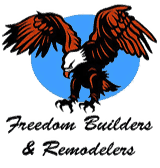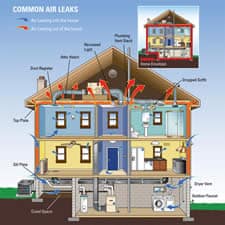Energy 101 – The Importance of Air Sealing
In this Home Energy 101 post, we are going to focus on air sealing of the home. It is one of the most cost effective ways to increase energy efficiency in Summer and Winter. No matter how well your house is insulated, if there are cracks and gaps, the air you just paid to heat or cool will quickly be lost. But air sealing is easy and relatively cheap as long as you know what areas to attack with the caulk gun.
As the seasons change, cracks and gaps will open and close and allow unwanted air to infiltrate, conditioned air to pass and moisture to leak into the home. This can cause a number of problems such as mold, drafts, and heat loss in the winter or gain in the summer.
Leaks can be sealed with caulk, spray foam or even just weather stripping depending on the problem area. A good rule of thumb is to use caulk for cracks smaller than 1/4-inch, and foam for larger cracks and gaps, though each condition may vary. We’d recommend checking these areas in your home:
Exterior:
- Windows & Doors: Insulate around frame with a low expanding foam insulation, caulk at frame & drywall/trim intersection, consider adding storm windows to single pane units.
- Wall Penetrations (pipes, vents, exhausts, air intakes, etc): Caulk around the perimeter of all exterior wall penetrations.
- Trim: Caulk around the perimeter of trim, and trim/siding intersections.
Interior:
- Windows & Doors: Caulk at frame & drywall/trim intersection, install weather stripping if needed, and add insulation and/or gaskets/weather stripping to attic access panels.
- Tubs & Showers: Caulk at shower/tub and wall intersection and around plumbing fixture perimeter.
- Outlets & Switches: Foam around perimeter of electrical box with low expanding foam, and install gaskets behind electrical plates.
- Lights: Caulk around light trim and use housing/cans that are labeled as insulated airtight fixtures.
- Trim: Caulk around trim.
- Pipes & Ductwork: Caulk any wall penetrations, wrap hot and cold water pipes with insulation, tape all duct joints and seams, and insulate ducts in any unconditioned spaces.
- Fireplaces: Keep damper closed (or install inflatable chimney balloon) when fireplace isn’t being used, consider adding glass gasket doors to fireplace opening when appropriate.
- Basements & Crawlspaces: Caulk or foam at the foundation wall & rim joist intersection and seal any cracks or joints in the foundation walls. See Seal Basement Air Leaks
If you’re unsure about where you need sealing, you can try the DIY method of inspecting your house with a lit incense stick — first turn off your HVAC and any running fans and close all windows and doors, then take the lit stick near any suspect leak, if the incense smoke is sucked in or blown away then you’ve confirmed your leak. Also, if you see any dirty spots on attic insulation, or dirt around any perimeter wall, door or window, then you very likely have a leak. An even better confirmation would be to get an energy audit, an auditor/inspector can do a number of tests and even use infrared cameras to detect leaks, moisture and air infiltration and inadequate insulation.
Most older homes will not have the issues of being too airtight, as there is always bound to be enough cracks and air leaks to keep a healthy level of fresh air circulation. If you are concerned with this issue, or are building a new tight home, you can install outside air intakes to be connected to your HVAC to bring in a steady exchange of new and stale air.
Air sealing your home will reduce your energy bills, increase the air quality of your home and decrease the maintenance required for associated air leak issues such as mold and rot. For more information visit:


A good and informative post
Hi Matt,
Thanks for stopping by and commenting.